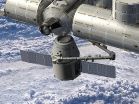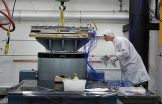RICHMOND, VA, March 07, 2013 (Press-News.org) About 428 miles above Earth, the collective observations from the "A-Train," or Afternoon Train build three-dimensional images of the Earth's atmosphere and surfaces. A team at NASA's Langley Research Center in Hampton, Va., is working to supplement those satellites with an instrument mounted to the orbiting International Space Station, or ISS.
According to Richard Eckman of the Earth Science Division of the Science Mission Directorate at NASA Headquarters in Washington, the satellites provide a means to make near simultaneous measurements of atmospheric processes.
NASA's Stratospheric Aerosol and Gas Experiment, or SAGE III on ISS, team intends to strengthen those measurements by providing important aerosol information concerning particles in the air, such as clouds or air pollution and other atmospheric gases, which are not currently captured. The space station's orbital inclination also provides an ideal view for consistent ozone measurements.
The instrument will provide a unique data set about the tropopause, the atmospheric boundary between the troposphere and the stratosphere, which will become available by combining data from SAGE III with data from the Atmospheric Chemistry Experiment, or ACE, a satellite mission on board the Canadian satellite SCISAT-1.
The troposphere is one of the lowest layers of the Earth's atmosphere; it is located right above the planetary boundary layer, and is the layer in which most weather phenomena take place.
"The tropopause region needs to be fully explored," said Joe Zawodny, SAGE III on ISS project scientist. "ACE and SAGE III on ISS are going to fly concurrently and what we can do with that data is very exciting. We can produce a backbone of international analysis."
Getting Ready for Launch
The SAGE III on ISS team is getting its instruments ready for a scheduled 2014 launch by following a rigorous testing and review schedule. In the fall of 2012, four engineering development components of SAGE III passed vibration testing at NASA Langley. Starting in January, the team began testing flight hardware. Those tests will continue through to launch.
After the project's Critical Design Review, scheduled for February 2013, the team will build additional flight hardware and complete refurbishment of existing equipment. All the pieces are scheduled to be ready for integration and testing in August 2013. After flight component tests are complete, the team will begin the launch-ready process.
Arrival to the International Space Station
SAGE III on ISS is set to launch on a SpaceX Falcon 9 rocket from NASA's Kennedy Space Center. Upon arrival to the space station, the crew will install the instrument onto an ExPRESS Logistics Carrier, or ELC, platform. It will take as long as 30 days to move the payload from the Falcon 9's Dragon truck and install it on the ELC. It will take another 30 days after installation for outgassing and to establish thermal control.
After a series of calibrations and check-outs, and an on-orbit acceptance review, SAGE III will begin taking measurements. The data is downloaded to the ground daily for use by the international science community.
"We are making great progress," said Mike Cisewski, SAGE III on ISS project manager. "It is important to extend the SAGE data record for the science community."
Why Do We Need Measurements from Space?
Like its predecessors SAGE I and II, which collected aerosol data from 1979 to 2005, SAGE III on ISS will measure aerosols, ozone, water vapor and other gases in Earth's atmosphere. According to Zawodny, it is an important time to study atmospheric gases, which help to shield everything on Earth from the sun's harmful ultraviolet rays. Scientists say that the protective ozone layer appears to be recovering and by 2015, it could be restored at least half way back to the initial protective layer that was observed in the late 1980s.
"Greenhouse gases and aerosols can be measured from the ground, but if you want to determine trends accurately, you have to capture it all," Zawodny said.
The complete data that SAGE III on ISS can provide will help to assess the state of recovery in distribution of the ozone, reestablish aerosol measurements needed by climate and ozone models, provide further insight into processes and trends, and predict global warming.
Once measurements begin, the science data will be assessed by the newly formed Science Utilization Team led by Pat McCormick of Hampton University in Hampton, Va. The ISS is expected to operate through at least 2017.
For more information on past, ongoing, and future ISS research activities, including research results and publications, visit:
http://www.nasa.gov/mission_pages/station/research/index.html
If you are interested in subscribing to updates from the ISS Program Science Office, visit:
https://lists.nasa.gov/mailman/listinfo/iss-program-science-group
For more information about the International Space Station, visit:
http://www.nasa.gov/station
Space Station Bound SAGE III is Full Steam Ahead
RELEASE: JR13-016
2013-03-07
ELSE PRESS RELEASES FROM THIS DATE:
Portion of hippocampus found to play role in modulating anxiety
2013-03-06
New York, NY— Columbia University Medical Center (CUMC) researchers have found the first evidence that selective activation of the dentate gyrus, a portion of the hippocampus, can reduce anxiety without affecting learning. The findings suggest that therapies that target this brain region could be used to treat certain anxiety disorders, such as panic disorder and post-traumatic stress syndrome (PTSD), with minimal cognitive side effects. The study, conducted in mice, was published today in the online edition of the journal Neuron.
The dentate gyrus is known to play a ...
Solving the 'Cocktail Party Problem': How we can focus on 1 speaker in noisy crowds
2013-03-06
In the din of a crowded room, paying attention to just one speaker's voice can be challenging. Research in the March 6 issue of the Cell Press journal Neuron demonstrates how the brain hones in on one speaker to solve this "Cocktail Party Problem." Researchers discovered that brain waves are shaped so that the brain can selectively track the sound patterns from the speaker of interest and at the same time exclude competing sounds from other speakers. The findings could have important implications for helping individuals with a range of deficits such as those associated ...
Study pinpoints, prevents stress-induced drug relapse in rats
2013-03-06
PROVIDENCE, R.I. [Brown University] — All too often, stress turns addiction recovery into relapse, but years of basic brain research have provided scientists with insight that might allow them develop a medicine to help. A new study in the journal Neuron pinpoints the neural basis for stress-related relapse in rat models to an unprecedented degree. The advance could accelerate progress toward a medicine that prevents stress from undermining addiction recovery.
In the paper published March 6, researchers at Brown University and the University of Pennsylvania demonstrated ...
Flip of a single molecular switch makes an old brain young
2013-03-06
The flip of a single molecular switch helps create the mature neuronal connections that allow the brain to bridge the gap between adolescent impressionability and adult stability. Now Yale School of Medicine researchers have reversed the process, recreating a youthful brain that facilitated both learning and healing in the adult mouse.
Scientists have long known that the young and old brains are very different. Adolescent brains are more malleable or plastic, which allows them to learn languages more quickly than adults and speeds recovery from brain injuries. The ...
Use it or lose it
2013-03-06
Boston, MA – "Use it or lose it." The saying could apply especially to the brain when it comes to protecting against Alzheimer's disease. Previous studies have shown that keeping the mind active, exercising and social interactions may help delay the onset of dementia in Alzheimer's disease.
Now, a new study led by Dennis Selkoe, MD, co-director of the Center for Neurologic Diseases in the BWH Department of Neurology, provides specific pre-clinical scientific evidence supporting the concept that prolonged and intensive stimulation by an enriched environment, especially ...
1 region, 2 functions: Brain cells' multitasking key to understanding overall brain function
2013-03-06
A region of the brain known to play a key role in visual and spatial processing has a parallel function: sorting visual information into categories, according to a new study by researchers at the University of Chicago.
Primates are known to have a remarkable ability to place visual stimuli into familiar and meaningful categories, such as fruit or vegetables. They can also direct their spatial attention to different locations in a scene and make spatially-targeted movements, such as reaching.
The study, published in the March issue of Neuron, shows that these very different ...
KLAS Celebrates 15 Years of Best in KLAS with Healthcare VIPs
2013-03-06
KLAS Enterprises celebrated 15 years of working with providers and vendors last night with their annual Best in KLAS awards reception in New Orleans. The event was attended by prominent healthcare leaders who came to support KLAS' ongoing effort to improve healthcare transparency.
The speakers for the evening included Jonathan Bush, CEO of athenahealth, Peter Smith, CEO and Co-Founder of Impact Advisors, and keynote speaker Russell Branzell, CEO of Colorado Health Medical Group. Branzell focused most of his comments on praising KLAS for being the "go-to source for ...
Health Care Providers Give Cloud Vendors High Marks on Security
2013-03-06
With an average satisfaction score of 4.5 out of 5 on security, cloud users feel safe. Non-cloud users though remain at bay--particularly with many questions still looming around the future of cloud computing in healthcare. The KLAS report titled Cloud Computing Perception 2013: The Hybrid Cloud in Healthcare looks at the evolution of the cloud in healthcare, provider concerns, as well as vendor performance.
Given the near-perfect satisfaction scores that cloud-users gave to their vendors, 66% of non-users surveyed said security was definitely the main issue stopping ...
Resistance to first line anti-malarial drugs is increasing on the Thai-Myanmar border
2013-03-06
Early diagnosis and treatment with antimalarial drugs (ACTs—artemisinin based combination treatments) has been linked to a reduction in malaria in the migrant population living on the Thai-Myanmar border, despite evidence of increasing resistance to ACTs in this location, according to a study by international researchers published in this week's PLOS Medicine.
These findings are important as this study suggests that alternative treatments are urgently needed to replace the failing first line drug regimen (mefloquine and artesunate).
The authors, led by François Nosten ...
Sharing HIV research findings with participants
2013-03-06
Is it feasible to share research findings with HIV-infected participants enrolled in observational research in rural sub-Saharan African? Anna Baylor and colleagues orally disseminated their findings to 477 research participants during a meeting modelled on a traditional wedding event. The information was enthusiastically received by participants. The meeting was a rewarding experience for the research team and identified new areas for investigation, say the authors.
###
Funding: The UARTO Study is funded by U.S. National Institutes of Health (NIH) RO-1 MH-54907 and ...
LAST 30 PRESS RELEASES:
New expert guidance urges caution before surgery for patients with treatment-resistant constipation
Solar hydrogen can now be produced efficiently without the scarce metal platinum
Sleeping in on weekends may help boost teens’ mental health
Study: Teens use cellphones for an hour a day at school
After more than two years of war, Palestinian children are hungry, denied education and “like the living dead”
The untold story of life with Prader-Willi syndrome - according to the siblings who live it
How the parasite that ‘gave up sex’ found more hosts – and why its victory won’t last
When is it time to jump? The boiling frog problem of AI use in physics education
Twitter data reveals partisan divide in understanding why pollen season's getting worse
AI is quick but risky for updating old software
Revolutionizing biosecurity: new multi-omics framework to transform invasive species management
From ancient herb to modern medicine: new review unveils the multi-targeted healing potential of Borago officinalis
Building a global scientific community: Biological Diversity Journal announces dual recruitment of Editorial Board and Youth Editorial Board members
Microbes that break down antibiotics help protect ecosystems under drug pollution
Smart biochar that remembers pollutants offers a new way to clean water and recycle biomass
Rice genes matter more than domestication in shaping plant microbiomes
Ticking time bomb: Some farmers report as many as 70 tick encounters over a 6-month period
Turning garden and crop waste into plastics
Scientists discover ‘platypus galaxies’ in the early universe
Seeing thyroid cancer in a new light: when AI meets label-free imaging in the operating room
Neutrophil-to-lymphocyte ratio may aid risk stratification in depressive disorder
2026 Seismological Society of America Annual Meeting
AI-powered ECG analysis offers promising path for early detection of chronic obstructive pulmonary disease, says Mount Sinai researchers
GIMM uncovers flaws in lab-grown heart cells and paves the way for improved treatments
Cracking the evolutionary code of sleep
Medications could help the aging brain cope with surgery, memory impairment
Back pain linked to worse sleep years later in men over 65, according to study
CDC urges ‘shared decision-making’ on some childhood vaccines; many unclear about what that means
New research finds that an ‘equal treatment’ approach to economic opportunity advertising can backfire
Researchers create shape-shifting, self-navigating microparticles
[Press-News.org] Space Station Bound SAGE III is Full Steam AheadRELEASE: JR13-016



